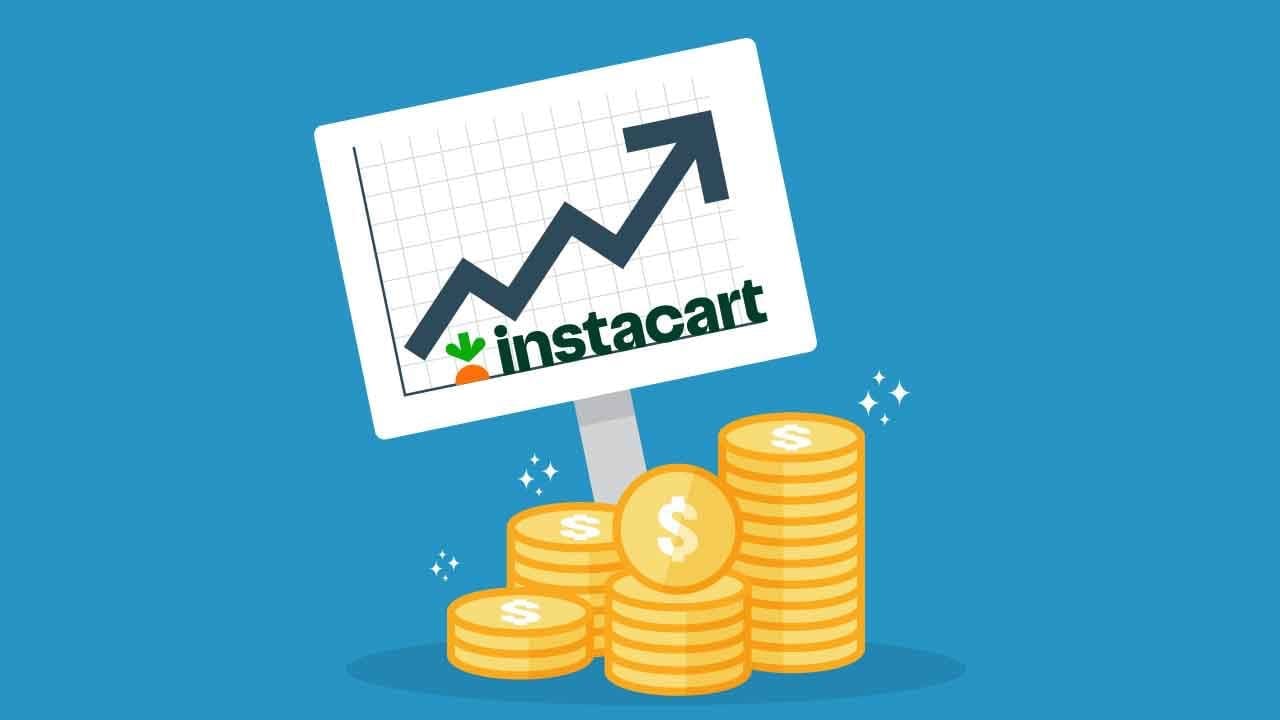How Does Instacart Make Money | Business Model & Revenue



Instacart is a grocery delivery service that has seen massive success in recent years. But how does instacart make money? What is the business model behind this popular company? In this blog post, we will explore six ways that Instacart generates revenue. We will also take a look at how the company is currently performing and what investors think of its future prospects.
Instacart bridges the gap between grocery stores and customers who want to order groceries online by acting as an integrator. In addition to this, it offers gig jobs opportunities to persons who are searching for either full-time or part-time work. Therefore, the following types of customers are included in the Instacart Business Model:
Users are the individuals who order groceries through the Instacart app or website.
Retailers are the grocery stores that partner with Instacart to offer delivery services.
And finally, Instacart Full Service Shoppers are the personal shoppers who fulfill orders placed by users and deliver groceries using their personal vehicles. There is no minimum wage for Shoppers. Instacart Shoppers can expect to make between $10 and $18 per hour, based on our previous experiences.
Each of these customer segments has different needs and requirements, which Instacart strives to meet. For example, users need an easy-to-use platform for ordering groceries, retailers need a reliable delivery service to reach their customers, and shoppers need a flexible job that allows them to set their own hours. By catering to the needs of all three customer segments, Instacart has become the leading on demand grocery delivery service in the United States.
Instacart was founded in 2012 by former Amazon employee Apoorva Mehta. Metha had previously worked in Amazon's fulfillment shipping services and saw the need for a grocery shopping app, so she immediately started developing the software that would later become Instacart.
Instacart Inc. is a technology company headquartered in San Francisco, California.
Instacart partners with local retailers to offer food and grocery delivery to customers on demand via the company's app.
The company has been successful in attracting customers and partners. In 2018, Instacart had over 300,000 active users and was available in more than 5000 stores across the United States. The company has also partnered with major retailers such as Costco, Kroger, Aldi, and Safeway.
The company has raised a total of $4.6 billion from investors, including Softbank, Sequoia Capital, and Andreessen Horowitz. Instacart has been growing rapidly, with sales increasing by 150% in 2016. The company is currently available in more than 250 markets across the United States and Canada. Instacart plans to use its new funds to expand into new markets and to continue to invest in technology.
During the coronavirus outbreak, Instacart became an important service, and its workers placed their lives in danger in order to deliver people's groceries to them. In light of the fact that the company is now employing hundreds of thousands of shoppers to meet this demand, the platform has already been adopted by millions of families as a way to get groceries without exposing themselves to the potential hazards of traveling to a grocery store.
Looking ahead, Instacart is focused on expanding its grocery delivery business. The company recently announced plans to add alcohol delivery in select markets. Instacart is also testing out new features such as subscription-based delivery and in-store pickup. With its strong user base and partnerships, Instacart is well positioned to continue growing in the years to come.
Instacart plans to list on the Nasdaq under the ticker "ICART." It is not yet clear when Instacart will go public, but the IPO is likely to value the company at over $20 billion. Instacart's IPO will be a major test for the burgeoning online grocery delivery industry. While there have been some successful IPOs in this space (such as Blue Apron), others have flopped (such as Mealpal).
Instacart is a grocery delivery service that allows users to shop for groceries online and then have them delivered to their doorsteps. Here's how it works: users first create an account on the Instacart website or mobile app. They then choose a local grocery store and browse through the store's selection of items.
Once they've added items to their cart, they select a delivery time and check out. An Instacart shopper will then go to the chosen store, purchase the items, and deliver them to the user's home. Users can also choose to pick up their groceries from the store themselves if they prefer. Instacart is a convenient way to get groceries without having to leave home, and it's becoming increasingly popular in cities across the United States.

Instacart is a privately held company and does not disclose its financials. The grocery delivery startup is now worth 14.7 billion after its latest funding round. This valuation makes it one of the most valuable startups in the world.
Instacart has seen strong growth in recent years, and its valuation has steadily risen. However, the company has also faced several challenges, including allegations of low pay and poor working conditions for its workers. Despite these challenges, Instacart continues to be a leader in the grocery delivery space, and its valuation is expected to continue to rise in the future.
Instacart's business model is a bit of a misnomer. The company doesn't have a single business model. Rather, it has five: one for each of the distinct markets in which it operates: grocery, alcohol, drugstores, pet food, and home improvement stores.
Each of these five business models is slightly different. But they all share one common element: they're all built on top of Instacart's propriety technology platform, which includes an app for shoppers and an app for retailers.
The heart of the Instacart platform is its crowdsourced shopping service. When a customer places an order through the Instacart app, that order is matched with a nearby personal shopper who will fulfill the order. The shopper then goes to the selected store, shops for the items on the customer's list, and delivers them to the customer's door.
Instacart makes the vast majority of its revenue from three sources: by charging customers a delivery fee for each order, by charging service fees, as well as a commission fee that retailers pay for each delivered order.
The company also generates revenue from advertisers and from retail partners who pay to have their products featured prominently in the app.
Let's take a look at the business strategy behind Instacart's revenue model to have a better understanding of how the company generates income.
The company makes money through commissions and fees charged to retailers.
Every time a product is purchased via Instacart's platform, the company earns a commission on the transaction. It is able to accomplish this goal as a result of a revenue sharing arrangement it has in place with its merchants.
After then, the company keeps a certain amount of the total price that the item sells for as profit. The precise sum is determined by the monetary terms of the deal that was struck with the store.
Instacart makes money by charging customers a delivery fee, a service fee. The delivery fee ranges from $3.99 to $9.99 depending on the order size and delivery time. The service fee is a percentage of the total order cost and is added on top of the delivery fee.
The company does not reveal how much of the service price goes into the wallets of its Dashers, despite the fact that these payments are used by the company to pay its drivers.
It is essential to keep in mind that Instacart does not add a markup to the prices of the groceries that it sells in order to generate a profit. Prices on the Instacart platform are determined by retailers, who voluntarily raise their prices in order to compensate for the commissions fees charged by Instacart.
Instacart also offers an annual subscription service called Instacart Plus (ex Instacart Express), which gives users free delivery on all orders over $35 and avoid excessive delivery fees. When you sign up for Instacart+ you can choose an annual or monthly plan. Instacart Express members get additional benefits including reduced service fees. Overall, Instacart subscription is a convenient service for busy people who don't have time to go to the grocery store, and it's also a great way to support local businesses.
Related Article: How To Cancel Instacart Plus
In addition to the fees it charges for delivery and service, Instacart also earns revenue from product placement and marketing services that it provides to its partner stores. This includes things like featured placement of certain products on the app, as well as in-app advertising.
Instacart allows brands and advertisers to buy promotional spots on their platform in order to increase visibility and sales. The price of the ad spot depends on the type of category and search term that is being targeted. Instacart's ads system is similar to that of other marketplace platforms, such as Amazon, Etsy, or the Wish App. This service provides an additional revenue stream for Instacart while also benefiting brands and advertisers by increasing their visibility on the platform.
These services help to offset the costs of running the platform, and allow Instacart to provide its customers with an overall selection that is both broad and deep. As a result, it is able to offer an exceptional level of convenience and value that has helped it to become one of the leading grocery delivery platforms in the United States.
Matt Jonna, CEO and co-founder of Plum Market, said in a statement. "We are committed to offering the best selection to our guests in a seamless online experience. The advertising capability within Instacart Platform enables a better experience for our guests to discover new products and ingredients on our app."
Instacart recently acquired SaaS company Foodstorm. Moving beyond the company's core business on grocery delivery via the use of gig workers, Instacart will now begin selling software services to supermarkets and other grocery businesses.
The Instacart Platform will provide software management services for ecommerce, fulfillment, advertisements, analytics, and other data for any grocery shop that wants to use it. Currently, only grocery stores who partner with Instacart for delivery services may take use of these services. In a news release, the CEO of the firm, Fidji Simo, said that the new software platform is built on the insights that the company has collected via collaborating with grocers on delivery and constructing unique digital shops.
Instacart has a business model that is different from other grocery delivery services. By charging both the customer and the store, they are able to make a profit on each order. This business model also allows them to keep their prices low for customers. Have you tried using Instacart? What did you think of the service?
We provide the best resources and information for the major ridesharing, bike sharing, kids sharing and delivery companies. Best UberEats Invite Code, Lyft driver Promo code and Postmates Referral code. Sign up at 100% working and they will give you the best sign up bonus at any given time.